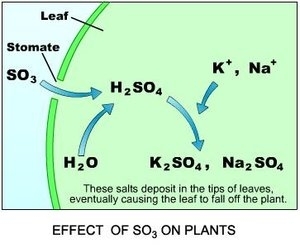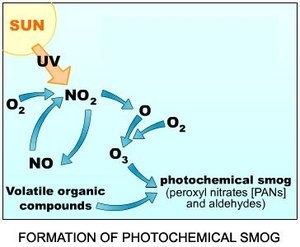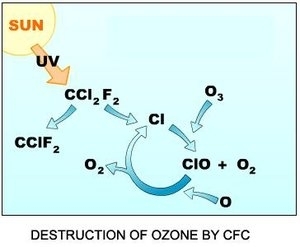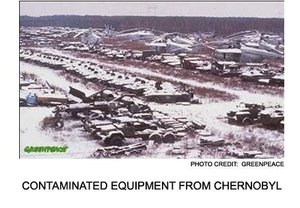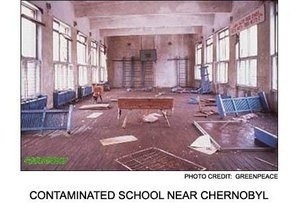AP Environmental Science Chapter 16- Air, Water and Soils
Contents
- 1 Chapter Objectives
- 2 Introduction
- 3 Air pollutants
- 4 Water pollutants
- 5 Soil pollutants
- 6 Chapter ReadingsPrinciples of Environmental Science: Inquiry & Application (McGraw-Hill)Chapter 7: 159 - 163, Chapter 9: 200 - 221, Chapter 10: 241 - 255Previous Chapter: Chapter 15-Land (AP Environmental Science Chapter 16- Air, Water and Soils) | Back to the full Online Course | Next Chapter: Chapter 17- Solid Waste (AP Environmental Science Chapter 16- Air, Water and Soils)
Chapter Objectives
Describe the sources and hazards of the primary and secondary air pollutants, and suggest ways to mediate their danger to human and environmental health.Describe the sources and hazards of the various classes of water pollutants, and suggest ways to mediate their danger to human and environmental health.Discuss the toxic effects, mobility, and persistence of different types of pesticides (AP Environmental Science Chapter 16- Air, Water and Soils) and herbicides. * Explain how specific habitats such as lakes and bays have been affected by the combined action of air (Air pollution emissions), water (Water pollution), and soil pollution.
Introduction
Human activities release a variety of substances into the biosphere (AP Environmental Science Chapter 16- Air, Water and Soils) , many of which negatively affect the environment. Pollutants discharged into the environment can accumulate in the air, water, or soil. Chemicals discharged into the air that have a direct impact on the environment are called primary pollutants. These primary pollutants sometimes react with other chemicals in the air to produce secondary pollutants.
A wide variety of chemicals and organisms are discharged into lakes, rivers and oceans daily. Left untreated, this sewage and industrial waste has a serious impact on the water quality, not only in the immediate area, but also downstream.
Air pollutants
The eight classes of air pollutants are: oxides of carbon, sulfur and nitrogen, volatile organic compounds, suspended particulate matter, photochemical oxidants, radioactive substances and hazardous air pollutants. Oxides of carbon include carbon monoxide (CO) and carbon dioxide ([[CO2]]). Carbon monoxide, a primary pollutant, is mainly produced by the incomplete combustion of fossil fuels. It is also present in cigarette smoke. The colorless, odorless gas is poisonous to air-breathing animals. Carbon monoxide binds to hemoglobin, impeding delivery of oxygen to cells. This causes dizziness, nausea, drowsiness, and headaches; at high concentrations it can cause death. Carbon monoxide pollution from automobiles can be reduced through the use of catalytic converters and oxygenated fuels.Carbon dioxide is produced by the complete combustion of fossil fuels. It is considered a greenhouse gas because it heats up the atmosphere by absorbing infrared radiation.
As a result of this characteristic, excess amounts of carbon dioxide in the atmosphere may contribute to global warming. Carbon dioxide can also react with water in the atmosphere and produce slightly acidic rain. Carbon dioxide emissions can be reduced by limiting the amount of fossil fuels burned.
Oxides of sulfur include sulfur dioxide (SO2) and sulfur trioxide (SO3). Sulfur oxides are primarily produced by the combustion of coal and oil. Oxides of sulfur have a characteristic rotten egg odor, and inhalation of them can lead to respiratory system damage. They react with atmospheric water to produce sulfuric acid, which precipitates as acid rain or acid fog. Acid rain is a secondary pollutant that acidifies lakes and streams, rendering the water unfit for aquatic life. It also corrodes metals, and dissolves limestone and marble structures.
Oxides of sulfur can be removed from industrial smokestack gases by "scrubbing" the emissions, by electrostatically precipitating the sulfur, by filtration, or by combining them with water, thereby producing sulfuric acid which can be used commercially.Oxides of nitrogen include: nitric oxide (NO), nitrogen dioxide (NO2), and nitrous oxide (N2O). Nitric oxide is a clear, colorless gas formed during the combustion of fossil fuels. Nitrogen dioxide forms when nitric oxide reacts with atmospheric oxygen; the reddish-brown pungent gas is considered to be a secondary pollutant. Exposure to oxides of nitrogen can cause lung damage, aggravate asthma and bronchitis, and increase susceptibility to the flu and colds. Nitrogen dioxide can combine with atmospheric water to form nitric acid, which is precipitated as acid rain. Nitrogen dioxide is also a key ingredient in the formation of photochemical smog, and nitrous oxide is a greenhouse gas.Automobile emissions of these pollutants can be reduced by catalytic converters which convert them to molecular nitrogen and oxygen.
Volatile organic compounds (VOCs) include hydrocarbons such as methane (CH4), propane (C3H8), and octane (C8H18), and chlorofluorocarbons (CFCs) such as dichlorodifluoromethane (CCl2F2).Hydrocarbons are released into the atmosphere in automobile exhaust and from the evaporation of gasoline. They contribute to the formation of photochemical smog. Chlorofluorocarbons were used as propellants for aerosols and as refrigerants until it was discovered they can cause depletion of the protective ozone layer. Volatile organic compound emissions can be reduced by using vapor-recovery gasoline nozzles at service stations and by burning oxygenated gasoline in automobile engines.Suspended particulate matter consists of tiny particles of dust, soot, asbestos, and salts, and of microscopic droplets of liquids such as sulfuric acid and pesticides. Sources of these pollutants include the combustion of fossil fuel (e.g. diesel engines) and road and building construction activity. Exposure to these particles can lead to respiratory irritation, reduction of lung capacity, lung cancer, and emphysema.
Photochemical oxidants are primarily produced during the formation of photochemical smog. Ozone (O3) is a highly reactive, irritating gas that causes breathing problems, as well as eye, nose, and throat irritation. It also aggravates asthma, bronchitis, and heart disease. Ozone and other photochemical oxidants can damage or kill plants, reduce visibility, and degrade rubber, paint, and clothes. Photochemical oxidants are secondary pollutants, and can be controlled by reducing the amount of nitrogen dioxide in the atmosphere.Radioactive substances include radon-222, iodine-131, and strontium-90. Radon is gas produced during the decay of uranium that is naturally present in rocks and building materials made with these rocks. It is known to cause lung cancer in humans. The other radioisotopes are produced by nuclear power plants (iodine-131) or are contained in the fallout from atmospheric nuclear testing (strontium-90). They can be introduced into the food chain through plants and become incorporated in the tissues of humans and other animals. Their ionizing radiation can produce cancers, especially those related to the thyroid and bone.Hazardous [[air (Air pollution emissions)] pollutants] include benzene (C6H6) and carbon tetrachloride (CCl4). Benzene is a common organic solvent with numerous industrial uses. Carbon tetrachloride was formerly used as a solvent in the dry cleaning business. It is still used in industrial processes. Exposure to these compounds can cause cancer, birth defects and central nervous system problems.
Animation: Photochemical Smog
Water pollutants
The eight classes of [[water (Water pollution)] pollutants] are: infectious agents, oxygen-depleting wastes, inorganic chemicals, organic chemicals, plant nutrient pollutants, sediments, radioactive materials and thermal pollution. Infectious agents such as bacteria, viruses, and parasitic worms enter water from human and animal waste, and cause diseases such as typhoid fever, cholera, hepatitis, amoebic dysentery, and schistosomiasis, a condition marked by blood loss and tissue damage.Oxygen-depleting wastes include animal manure in feedlot and farm runoff, plant debris, industrial discharge, and urban sewage. They are consumed by aerobic bacteria. Excessive growth of these organisms can deplete water of dissolved oxygen which leads to eutrophication and the eventual death of oxygen-consuming aquatic life.
Inorganic chemical pollutants include mineral acids, toxic metals such as lead, cadmium, mercury, and hexavalent chromium, and mineral salts.
They are found in industrial discharge, chemicals in household wastewater, and seepage from municipal dumps and landfills. The presence of inorganic chemical pollutants in water can render it undrinkable, as well as cause cancer and birth defects. In addition, sufficient concentrations of these chemicals in water can kill fish and other aquatic life, cause lower crop yields due to plant damage, and corrode metals.
Organic chemical pollutants encompass a wide variety of compounds including oil, gasoline, pesticides, and organic solvents. They all degrade the quality of the water into which they are discharged. Sources of these pollutants include industrial discharge and runoff from farms and urban areas. Sometimes these chemicals enter aquatic ecosystems directly when sprayed on lakes and ponds (e.g. for mosquito control). These types of chemicals can cause cancer, damage the central nervous system and cause birth defects in humans.
Plant nutrient pollutants are found mainly in urban sewage, runoff from farms and gardens, and household wastewater. These chemicals include nitrates (NO3-), phosphates (PO43-) and ammonium (NH4+) salts commonly found in fertilizers and detergents. Too much plant nutrients in the water can cause excessive algae growth in lakes or ponds. This, in turn, results in the production of large amounts of oxygen-depleting wastes. The subsequent loss of dissolved oxygen causes eutrophication of the lakes or ponds.
Erosion of soils is the main process contributing sediments, or silts, to water bodies.Sediments can cloud the water of streams and rivers, reducing the amount of available sunlight (Solar radiation) to aquatic plants. The concurrent reduction in photosynthesis can disrupt the local ecosystem. Soil from croplands deposited in lakes and streams can carry pesticides, bacteria, and other substances that are harmful to aquatic life. Sediments can also fill up or clog lakes, reservoirs, and waterways limiting human use and disrupting habitats.
Radioactive materials such as iodine-131 and strontium-90 are found in nuclear power plant effluents and fallout from atmospheric nuclear testing. They can be introduced into the food chain through plants and become incorporated in body tissues of humans and animals. Their ionizing radiation can produce cancers, especially in the thyroid and bone where they tend to concentrate.
A power generating plant commonly discharges water used for cooling into a nearby river, lake, or ocean. Because the discharged water can be significantly warmer than the ambient environment, it represents a source of thermal pollution. Industrial discharges are also sources of thermal pollution.The increased temperature of the water may locally deplete dissolved oxygen and exceed the range of tolerance of some aquatic species, thus disrupting the local ecosystem.
Processing water in treatment plants can reduce the amounts of infectious agents, oxygen-depleting wastes, inorganic chemicals, organic chemicals and plant nutrients. Bans and restrictions on the use of certain chemicals, such as those on DDT and hexavalent chromium compounds, are also very helpful in reducing the amounts of these chemicals in the environment. By limiting exposure to these harmful substances, their negative effects on humans and local ecosystems can be greatly reduced.
Animation: Lake Eutrophication
Video: Ocean Environmental Awareness (High Bandwidth); (Low Bandwidth)
Soil pollutants
The persistence of pesticides in the soil is related to how quickly these chemicals degrade in the environment. There are three ways pesticides are degraded in the soil: biodegradation, chemical degradation, and photochemical degradation. Microorganism activity plays the predominant role in the biodegradation of pesticides. Water plays an important role in the chemical degradation of pesticides (e.g. some pesticides are hydrolyzed on the surfaces of minerals by water). Exposure to sunlight can also degrade some pesticides.
A variety of pesticides are used to control insects, weeds, fungi, and mildew in agricultural, garden, and household environments. There are three classes of pesticides: insecticides, which kill insects; herbicides, which kill plants; and fungicides, which kill fungi. Each of these classes includes different types of chemicals. These chemicals differ in chemical composition, chemical action, toxicity, and persistence (residence time) in the environment.
Some of these pesticides can bioaccumulate (e.g. they concentrate in specific plant and animal tissues and organs). Pesticides can accumulate in the soil if their structures are not easily broken down in the environment. Besides rendering the soil toxic to other living organisms, these pesticides may leach out into the groundwater, polluting water supplies.
The five classes of insecticides are: chlorinated hydrocarbons, organophosphates, carbamates, botanicals and synthetic botanicals. Chlorinated hydrocarbons such as DDT, are highly toxic in birds and fishes, but have relatively low toxicity in mammals. They persist in the environment, lasting for many months or years. Because of their toxicity and persistence, their use as insecticides has been somewhat restricted. Organophosphates, such as Malathion, are more poisonous than other types of insecticides, but have much shorter residence times in the environment.
Thus, they do not persist in the environment and cannot bioaccumulate. Carbamates, such as Sevin, are generally less toxic to mammals than are organophosphates. They also have a relatively low persistence in the environment and usually do not bioaccumulate. Botanicals, such as camphor, are derived from plant sources. Many of these compounds are toxic to mammals, birds, and aquatic life. Their persistence in the environment is relatively low, and as a result bioaccumulation is not a problem. Synthetic botanicals, such as Allethrin, generally have a low toxicity for mammals, birds, and aquatic life, but it is unclear how persistent they are and whether or not they bioaccumulate.
The three classes of herbicides are: contact chemicals, systemic chemicals and soil sterilants. Most herbicides do not persist in the soil for very long. Contact chemicals are applied directly to plants, and cause rapid cell membrane deterioration. One such herbicide, Paraquat, received notoriety when it was used as a defoliant on marijuana fields. Paraquat is toxic to humans, but does not bioaccumulate. Systemic chemicals, such as Alar, are taken up by the roots and foliage of plants, and are of low to moderate toxicity to mammals and birds; some systemic herbicides are highly toxic to fishes. These compounds do not have a tendency to bioaccumulate. Soil sterilants such as Diphenamid, render the soil in which the plants lives toxic. These chemicals have a low toxicity in animals, and do not bioaccumulate.
Fungicides are used to kill or inhibit the growth of fungi. They can be separated into two categories: protectants and systemics.
Protectant fungicides, such as Captan, protect the plant against infection at the site of application, but do not penetrate into the plant. System fungicides, such as Sovran, are absorbed through the plant's roots and leaves and prevent disease from developing on parts of the plant away from the site of application. Fungicides are not very toxic and are moderately persistent in the environment.
Soil can absorb vast amount of pollutants besides pesticides every year. Sulfuric acid rain is converted in soil to sulfates and nitric acid rain produces nitrates in the soil. Both of these can function as plant nutrient pollutants. Suspended particulate matter from the atmosphere can accumulate in the soil, bringing with it other pollutants such as toxic metals and radioactive materials.
